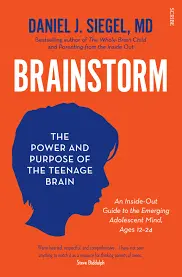Understanding Teenage Brain Development
Several recent books have focused on the teenage brain in an effort to help parents understand what’s going on with their teenager. But Brainstorm: The Power and Purpose of the Teenage Brain takes it a step further by helping parents—and teenagers—use the science to improve their overall experience of adolescence. This issue, Your Teen talked with Daniel J. Siegel, MD, a clinical professor of psychiatry at UCLA School of Medicine, about his New York Times bestseller.
Q: What was your inspiration for this book?
Siegel: There were several. As a father of two kids now in their 20s, I wanted to understand what happened to them in adolescence. As a clinician, an educator, and a scientist, I was intrigued by new discoveries in the science of brain development that have been made in the past five to ten years. These discoveries directly contradicted some of the popular beliefs, myths, and false statements about adolescence, like teens have “raging hormones” or are “lazy” or “out of control”—negative stereotypes which are really destructive not only to adolescents themselves, but to parents and teachers as well. I reviewed the books out there on the subject of adolescent brain development and found that none of them were written about teens for teens, and that most were, in fact, quite derogatory toward teens.
Q: So your goal is to help teens, as well as adults, understand the changes the teenage brain is undergoing?
Siegel: Yes, this book is very accessible and intended to help teens make sense of their lives. For me, it’s exciting to provide teens with new information that really clarifies the truth about brain remodeling going on in those adolescent years, and what they can do about it. It’s incredibly gratifying to be able to offer research-inspired exercises and techniques that can actually help teens integrate their brains, and support and encourage healthy brain development and growth.
Q: How have recent discoveries in brain development changed how we understand the teen brain?
Siegel: Discoveries from brain imaging studies reveal surprising changes in the structure and function of the brain during adolescence. Old theories of the brain viewed the brain’s master control center—the prefrontal cortex, at the forward part of the frontal lobe—as simply not mature until the end of adolescence, and that the “immaturity” of the brain explained “immature” teenage behavior. This is not quite consistent with what research is showing us, which is that adolescence is an important, necessary phase and that the restructuring changes that occur in the adolescent brain are vitally important developmental changes that enable new abilities to emerge. Many of the brain’s changes during adolescence involve increasing the levels of i
Q: What do you mean when you say “integration”?
Siegel: When we speak of integration, we refer to a system which has differentiated parts that become linked and then function as a whole, which is greater than the sum of its parts. Integration—where the various different functions and parts work together—is really the basis of well-being. Emerging research shows us that the general purpose of adolescent brain development is growth toward integration.
Q: What are some of the changes that happen in the teenage brain?
Siegel: During adolescence, remodeling occurs where the brain prunes away a number of its basic cells, its neurons and their connections, and its synapses, and then increases linkage among the remaining parts. Those remaining parts become quicker, more coordinated, and more effective. The result of this architectural restructuring in the brain is the emergence of the adolescent mind, which is wonderfully creative, adaptive, and vibrant. Adolescence is really the golden age for innovation and creating new ways of doing things.
Q: What should parents take away from these discoveries about the teen brain?
Siegel: The adolescent brain is a construction zone, and the changes in the brain in this period create the “essence” of adolescence: creativity, innovation, the capacity for abstract thinking, and the drive for experimentation. Sometimes as adults, we see the adolescent drive towards experimentation only as a negative, as a problem, a sign of teens being “crazy” or immature. But the science of brain development shows us that this innate adolescent drive for innovation and the creation of new ways of doing things is natural and healthy. If we reject or push back against these natural changes, the result can shut down communication and become destructive. Hopefully, if both adolescents and adults can appreciate these important years of innovation and transition as assets rather than liabilities, then adults will be able to help adolescents navigate this period and reach their full potential.




